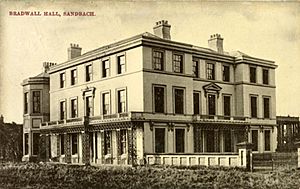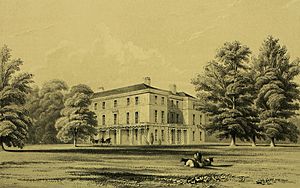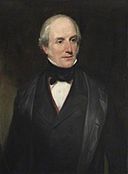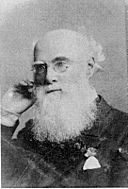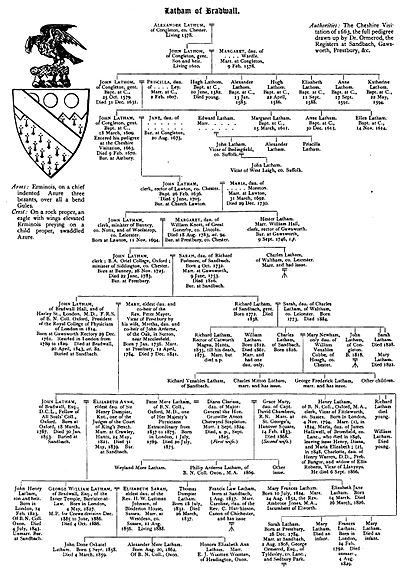Latham of Bradwall facts for kids
The Latham of Bradwall family lived at Bradwall Hall, near Sandbach, England. This family had many important members. They were a younger branch of the ancient Lathom family from Lathom and Knowsley. The main Lathom family line ended when Isabella Latham married Sir John Stanley. He was an ancestor of the Earls of Derby.
Meet the Latham Family of Bradwall
John Latham (1761–1843): A Famous Doctor
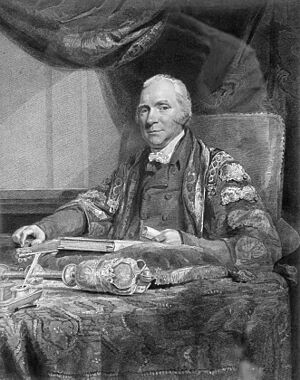
John Latham was a well-known doctor born on December 29, 1761. He bought the Bradwall estate. He became the President of the Royal College of Physicians. He also helped update their official book of medicines, called the Pharmacopoeia.
John was the oldest son of Reverend John Latham. He was born in Gawsworth, Chester, at his great-uncle's house. He went to Manchester Grammar School and then to Brasenose College, Oxford, in 1778. He earned his medical degrees there. He finished his medical training in London at St. Bartholomew's Hospital.
He worked as a doctor in Manchester and Oxford first. In both cities, he was chosen as a physician for the local hospitals. In 1788, he moved to London. The next year, he became a Fellow of the College of Physicians.
Soon after, he became a physician at the Middlesex Hospital. Then he worked at the Magdalen Hospital. In 1792, he took over from David Pitcairn at St. Bartholomew's Hospital. He lived in Bedford Row until 1808, then moved to Harley Street. In 1790, he was appointed as a special physician to the Prince of Wales. He later held the same job for George IV.
He was very active at the College of Physicians. He was an examiner (censor) in 1790. He gave important lectures there, including the Gulstonian lectures in 1793 and the Harveian oration in 1794. He was President of the College from 1813 to 1819.
In 1801, he bought the Bradwall estate in Sandbach. He also became a Fellow of the Royal Society that same year. In 1816, he started the Medical Benevolent Society. He stopped working in 1829.
John Latham passed away on April 20, 1843, at Bradwall Hall. He was buried at St Mary's Church, Sandbach. His gravestone can be seen there. Two paintings of Dr. Latham were made. One shows him as President of the College of Physicians. A copy of this painting is at Brasenose College, Oxford.
On April 12, 1784, he married Mary Mayer. She was the oldest daughter of Reverend Peter Mayer. They had four daughters and five sons. Only two daughters and three sons lived to be adults. These included Sarah, John (who inherited the estate), Peter, and Henry.
John Latham (1787–1853): A Magistrate and Poet
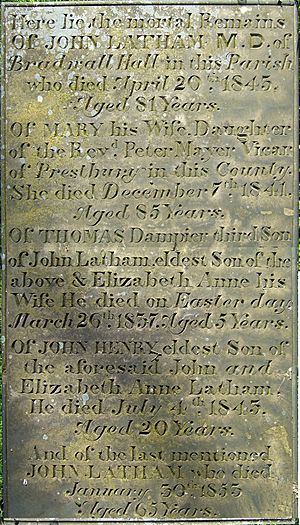
John Latham was born on March 18, 1787, in Oxford. He was the oldest son of Dr. John Latham (1761–1843). He became a local judge (magistrate) and a poet. He is buried in Sandbach.
He went to Brasenose College, Oxford, in 1803. In 1806, he won a special prize for his Latin poem about the Battle of Trafalgar. His two younger brothers, Dr. Latham and Reverend Henry Latham, also won similar prizes in later years. In 1844, these three brothers gave a special memorial window to the Sandbach church. This was to remember their parents.
In 1806, John Latham became a Fellow of All Souls' College, Oxford. He earned degrees in Civil Law. When his father passed away in 1843, he inherited the Bradwall estates. He lived at Bradwall Hall and worked as a county magistrate. He was also very involved in local education and charity groups.
On May 24, 1821, he married Elizabeth-Anne Dampier. She was the oldest daughter of Sir Henry Dampier, a judge. In 1839, his wife passed away. Then, his oldest son, John Henry Latham, also died. His son was a very promising young man.
Three of his children lived longer than him: George William, Francis-Law, and Mary-Frances. George William later lived at Bradwall Hall. John Latham was buried in the family burial place at Sandbach church on February 3, 1853.
Peter Mere Latham (1789–1875): A Medical Teacher
Peter Mere Latham was a doctor and a great teacher of medicine. He was the son of John Latham (1761–1843).
He was born in London on July 1, 1789. He was a very delicate child. He went to Sandbach School and lived with his grandmother. Around 1796, he moved to Macclesfield Grammar School. In 1807, he went to Brasenose College, Oxford. He earned his medical degree from Oxford in 1818. That same year, he became a Fellow of the College of Physicians. He gave their Gulstonian lectures in 1819 and the Harveian oration in 1839.
In 1815, he became a physician at the Middlesex Hospital. In 1824, he moved to St Bartholomew's. When Queen Victoria became queen in 1837, he was appointed as her special physician. He retired to Torquay in 1865. He passed away there on July 20, 1875, at 86 years old.
He was married twice. His first wife, Diana Clarissa Chetwynd Stapleton, died within a year of their marriage in 1825. On February 14, 1833, he married Grace Mary Chambers. They had four children: two sons, Weyland Mere and Philip Arderne, and two daughters, Diana Frances and Mary Grace.
Sarah Ormerod (1784–1860): Artist and Educator
Sarah Ormerod was born Sarah Latham in 1784. Her parents were Mary Mayer and John Latham (1761-1843). Her father, John Latham, married Mary Mayer in 1784. Sarah was their oldest daughter. She spent her early years in Manchester, where her father worked as a doctor.
When she was three, her family moved to Oxford. Her father became a physician at the Radcliffe Infirmary. In 1788, the family moved to London. Her father became a Fellow of the Royal College of Physicians in 1789. He also served as a special physician to the Prince of Wales starting in 1795. In 1802, he bought Bradwall Hall in Sandbach, Cheshire, and the family moved to the countryside.
In 1808, Sarah Latham married George Ormerod. He was a historian and a local judge from Cheshire. They lived in several places, including Rawtenstall, Great Missenden, and Damhouse in Astley. Their sons Thomas Johnson and George Wareing were born in 1809 and 1810. In 1811, they moved to Chorlton House. This allowed George to research for his three-volume book, History of Cheshire. They lived there until 1823 and had five more sons and three daughters.
Their children included:
- Thomas Johnson Ormerod (1809–74), a religious minister.
- George Wareing Ormerod (1810–91), a lawyer and geologist.
- John Arderne Ormerod (1813–64), a religious minister.
- Susan Mary Ormerod (1814–96), an amateur artist.
- Henry Mere Ormerod (1816–98), a lawyer.
- William Piers Ormerod (1818–60), an anatomist and surgeon.
- Edward Latham Ormerod (1819–73), a physician.
- Arthur Stanley Ormerod (1821–84), a religious minister.
- Georgiana Elizabeth Ormerod (1822–96), a scientific illustrator.
- Eleanor Anne Ormerod (1828–1901), an entomologist (someone who studies insects).
The Ormerod family lived in the countryside and were very close. Sarah Ormerod taught her children at home when they were young. Many of her sons later went to Oxford. The educator Thomas Arnold praised their early home education. Sarah also strongly believed in educating her daughters. She taught them Bible studies, English, French, geography, music, sewing, and drawing. She helped her daughters Susan Mary, Eleanor, and Georgiana with their studies of nature and art. Eleanor Anne Ormerod became a famous entomologist. Georgiana became the illustrator for her sister's findings.
Sarah Ormerod was a talented artist herself. She loved botany (the study of plants). She shared this interest with her children. She studied oil painting when she was young. She also hired watercolor artists to teach her daughters. Her graphite drawings were shown in 2014 at the Natural History Museum, London.
Sarah Ormerod died on April 11, 1860, at 75 years old. She was buried at Sedbury Park, Gloucestershire.
Charles Latham (1816–1907): A Community Doctor
Charles Latham was a physician, surgeon, and registrar from Sandbach. He was born in 1816 and passed away on July 7, 1907. He was a member of the Royal College of Surgeons (MRCS). In 1839, he joined the Worshipful Society of Apothecaries (LSA). He was known as "old Dr Latham" by many.
Charles was the third son of Richard and Sarah Latham. He was also the nephew of John Latham (1761–1843). He trained at Manchester Hospital for five years. After that, he worked at the Manchester Infirmary. Then he moved to London. He earned his medical certificates at St. Bartholomew's Hospital. He then returned to Sandbach and became a partner with Mr. Sutton.
On March 29, 1842, he became the medical officer for the Sandbach Relief District. He held this job for 57 years, retiring in 1899. He also served as a medical officer for the District workhouse for almost 60 years. For over 30 years, he was the public vaccinator. He was also a surgeon at the Bradwall Reformatory until 1903. For some time, he recorded births and deaths. He handed this duty over to his son in 1888.
In 1843, he married Mary Newnham Cobbe. They had several children, including Richard Venables, William Henry, Catherine Maria, George Frederick, Louisa Mary, Harry Newham, and Francis Gordon.
George William Latham (1827–1886): A Politician and Landowner
George William Latham was the son of John Latham (1787–1853). He was an English landowner, a lawyer, and a Liberal politician.
He was born in London on May 4, 1827. He studied at Brasenose College, Oxford. He became a lawyer at the Inner Temple in 1852. For a while, he worked as a lawyer in the Chester and North Wales area.
After practicing law, he moved to Bradwall Hall. He became very involved in county affairs. He was especially interested in schools for young people who needed help. He even started one on his own property, called Bradwall Reformatory School. He also cared a lot about farming and was active in the Cheshire Chamber of Agriculture.
In politics, he was a strong Liberal. In the 1878 election, he ran for Parliament in Mid-Cheshire but lost. He ran again in 1880 and 1883, losing both times but by smaller margins. However, in 1885, he was elected as a Member of Parliament for the Crewe division. He won against his opponent, Mr. O. Leslie Stephen.
At the next election in June 1886, he could not run again because of serious health problems. He passed away on October 4, 1886, at Bradwall Hall.
Latham Family Tree
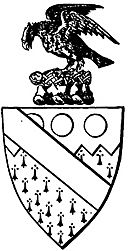
The Latham family of Bradwall is connected to the Lathams of Lathom in Lancashire and Astbury in Cheshire. In 1851, the historian George Ormerod (who married Sarah Latham) wrote about the family's history. He explained that the Bradwall family is linked to the older Lathom family through several important female lines.
Images for kids


